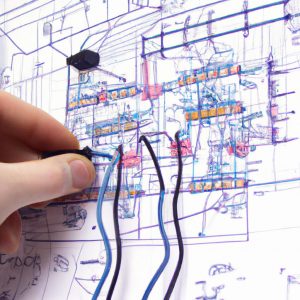Resistance: Its Role in the Physics of Electricity

The phenomenon of resistance plays a crucial role in the field of physics, particularly in understanding and analyzing the behavior of electricity. Resistance refers to the property of an electrical component or material that hinders the flow of electric current through it. It is measured in ohms (Ω) and can vary depending on various factors such as temperature, length, and cross-sectional area. To illustrate its significance, consider the following hypothetical scenario: imagine a circuit consisting of a battery connected to a lightbulb with two different wires – one made of copper and another made of steel. The presence of resistance will cause variations in the amount of current flowing through each wire, resulting in differences in brightness between the two bulbs.
Resistance not only affects the flow of electric current but also influences other important properties within electrical circuits. Understanding how resistance functions allows scientists and engineers to design efficient systems that optimize energy usage while minimizing power loss due to resistive effects. Furthermore, studying resistance enables researchers to explore numerous applications related to electronics, telecommunications, and power transmission. By comprehending this fundamental concept, we are able to delve deeper into the intricate workings behind electrical phenomena and develop innovative solutions for practical challenges encountered in our modern world. In this article, we will examine the principles underlying resistance and explore its various applications across different fields of science and technology.
Definition of Resistance
Resistance: Its Role in the Physics of Electricity
Electricity is a fundamental aspect of our modern world, powering everything from simple lightbulbs to complex machinery. However, not all materials allow electricity to flow freely through them. This property, known as resistance, plays a crucial role in understanding and harnessing the power of electricity.
To grasp the concept of resistance, let us consider an example scenario. Imagine a wire connecting a battery to a lightbulb. In this case, if the wire has low resistance, electrical current will flow easily through it, allowing the lightbulb to shine brightly. On the other hand, if the wire has high resistance, less current will be able to pass through it, resulting in a dim or non-functional lightbulb.
Defining resistance can be challenging without delving into some technical terms. Nonetheless, we can understand it as the opposition that an object or material presents to the flow of electric current passing through it. Put simply; higher resistance means more difficulty for electrons to move within the material.
Now let’s explore four key characteristics associated with resistance:
- Magnitude: Resistance is measured in ohms (Ω), named after German physicist Georg Simon Ohm who first described its relationship with voltage and current.
- Dependence on Material: Different materials exhibit varying degrees of resistivity; some offer very little opposition while others hinder current significantly.
- Temperature Sensitivity: The resistance of certain materials changes with temperature variations – increasing or decreasing depending on their thermal properties.
- Length and Cross-sectional Area: Longer wires tend to have higher resistance than shorter ones due to increased distance for electron movement. Similarly, thinner wires present greater obstruction compared to thicker counterparts.
In summary, understanding resistance is vital for comprehending how electricity behaves within different materials or objects. It influences how efficiently energy flows from one point to another and enables engineers and physicists alike to design and optimize electrical systems.
With a fundamental understanding of resistance established, we can now delve into Ohm’s Law and its relationship with this intriguing property. By exploring the mathematical principles behind resistance, we gain further insight into how it affects the physics of electricity.
Ohm’s Law and Resistance
Resistance is a fundamental concept in the physics of electricity, playing a crucial role in understanding and analyzing electrical circuits. Building upon our previous discussion on the definition of resistance, let us now delve into Ohm’s Law and its relationship with resistance.
To illustrate the significance of resistance, consider a hypothetical scenario where we have two identical light bulbs connected to a battery. However, one bulb has high resistance while the other has low resistance. As current flows through both bulbs, we would observe that the bulb with higher resistance emits less light compared to its counterpart. This example highlights the influence of resistance on the flow of electric current and how it affects the behavior of devices within an electrical circuit.
Now, let us explore Ohm’s Law—a fundamental relationship between voltage (V), current (I), and resistance (R). According to Ohm’s Law, the current flowing through a conductor is directly proportional to the voltage applied across it and inversely proportional to its resistance. Mathematically, this can be expressed as V = IR, where V represents voltage in volts, I denotes current in amperes, and R symbolizes resistance in ohms.
Understanding Ohm’s Law enables engineers and scientists to analyze various electrical systems by calculating unknown values such as voltage or resistances. By rearranging the formula for Ohm’s Law, we can determine specific quantities based on known parameters. This allows for precise calculations when designing circuits or troubleshooting issues related to electrical components.
In summary, grasping the concept of resistance paves the way for comprehending Ohm’s Law—an essential principle governing electrical phenomena. The relationship established by Ohm’s Law provides invaluable insights into how voltage influences current flow through conductors with different resistive properties. In our subsequent section about “Factors Affecting Resistance,” we will explore additional factors that contribute to varying levels of electrical resistance within circuits—further expanding our knowledge on this fundamental aspect of electricity.
Factors Affecting Resistance
Resistance plays a crucial role in the physics of electricity, influencing how current flows through a circuit. In this section, we will explore various factors that affect resistance and their implications on electrical systems.
To illustrate the impact of resistance, let’s consider a hypothetical scenario where two identical light bulbs are connected to separate circuits with different resistances. Circuit A has low resistance, while circuit B has high resistance. When both circuits are connected to the same power source, we would observe that circuit A allows more current to flow compared to circuit B. This example demonstrates how resistance affects the amount of current flowing through a circuit.
There are several key factors that influence resistance:
-
Material: Different materials have varying levels of conductivity. For instance, metals such as copper or aluminum have low resistivity and thus offer less opposition to the flow of electric charge. Conversely, insulators like rubber or plastic have high resistivity and impede the movement of charged particles.
-
Length: Resistance increases with the length of the conductor used in a circuit. Longer conductors provide more obstacles for electrons to navigate, resulting in higher overall resistance.
-
Cross-sectional area: The thickness or cross-sectional area of a conductor determines its ability to carry current efficiently. Larger cross-sectional areas allow for easier electron flow and lower resistance.
-
Temperature: In most cases, an increase in temperature leads to an increase in resistance within materials due to increased atomic vibrations hindering electron movement.
To further understand these factors affecting resistance, refer to the following table:
| Factor | Effect on Resistance |
|---|---|
| Material | Lowers/Increases |
| Length | Increases |
| Cross-sectional Area | Lowers/Increases |
| Temperature | Increases |
By considering these factors and understanding their impact on electrical systems, engineers and scientists can design efficient circuits tailored for specific applications while minimizing energy loss due to excessive resistance.
Transitioning into the subsequent section, we will explore the relationship between resistance and current. Understanding this relationship is vital for comprehending how electric circuits function and can aid in troubleshooting potential issues that may arise.
Relationship between Resistance and Current
Resistance plays a crucial role in the physics of electricity, influencing how electrical current flows through a circuit. In the previous section, we explored the various factors that can affect resistance. Now, let us delve deeper into understanding the relationship between resistance and current.
To illustrate this connection, consider an example where different resistors are connected in series within a circuit. A resistor with high resistance will impede the flow of current more than one with lower resistance. This results in a decrease in the overall current flowing through the circuit. Conversely, when resistors are connected in parallel, each path offers less resistance to the flow of current compared to when they are connected in series. As a result, the total current increases.
Understanding this relationship is essential for several reasons:
- Efficiency: By controlling and manipulating resistance values, engineers can design circuits to optimize energy usage and minimize power loss.
- Safety: Properly managing resistance helps prevent excessive currents that could lead to overheating or damage to electrical components.
- Circuit Analysis: Analyzing the effects of changing resistances allows for accurate predictions of circuit behavior under different conditions.
- Device Functionality: Resistance influences device operation and performance characteristics such as voltage drops and heating elements.
Here is an emotional bullet point list highlighting key takeaways from our exploration:
- Understanding resistance enables efficient use of electrical energy.
- Appropriate management of resistance ensures safety in electrical systems.
- Analysis of changes in resistance aids accurate prediction of circuit behavior.
- Resistance directly impacts device functionality and performance.
Now let’s visualize these concepts further by considering a three-column table showcasing examples of devices with varying degrees of resistance:
| Low Resistance | Medium Resistance | High Resistance |
|---|---|---|
| LED bulbs | Household appliances | Heating elements |
| Copper wire | Motors | Carbon composition resistors |
| Superconducting materials | Speakers | Incandescent light bulbs |
In conclusion, the relationship between resistance and current is integral to understanding how electricity behaves in a circuit. By exploring this relationship, we can optimize energy usage, ensure safety, and accurately predict circuit behavior. In the subsequent section about “Resistance in Series and Parallel Circuits,” we will further examine these concepts within specific circuit configurations.
Resistance in Series and Parallel Circuits
Resistance in electrical circuits plays a crucial role in the physics of electricity. In the previous section, we explored the relationship between resistance and current, highlighting how an increase in resistance leads to a decrease in current flow. Now, let’s delve deeper into the concept of resistance by examining its behavior in series and parallel circuits.
To understand the effects of resistance in different circuit configurations, let’s consider an example scenario: imagine two light bulbs connected to a power source. In a series circuit, where components are connected one after another, both light bulbs share the same current flowing through them. Consequently, if one bulb has higher resistance than the other, it will consume more energy and emit less light compared to its counterpart with lower resistance. Conversely, in a parallel circuit where components are arranged side by side, each bulb receives an equal voltage but can have different resistances. As a result, the bulb with lower resistance will draw more current and shine brighter than its high-resistance counterpart.
Understanding this interplay between resistance and circuit configuration is essential for various applications involving electricity. Let’s take a closer look at some key points related to resistance:
- Resistance limits electric current: A higher value of resistance restricts the flow of electrons through a conductor.
- Ohm’s Law governs resistor behavior: According to Ohm’s Law (V = IR), the voltage across a resistor is directly proportional to the current passing through it.
- Temperature affects resistance: Some materials show variations in their resistive properties when subjected to temperature changes.
- Resistivity determines material suitability: Different materials possess distinct resistivities that determine their effectiveness as conductors or insulators.
Now let’s visualize these aspects by considering a table:
| Circuit Configuration | Current Flow | Voltage Across Components |
|---|---|---|
| Series | Shared | Divided |
| Parallel | Divided | Same |
As we can see from the table, the behavior of resistance in series and parallel circuits leads to distinct outcomes. This understanding is fundamental for designing electrical systems and ensuring optimal performance.
In our subsequent section on “Applications of Resistance in Electrical Devices,” we will explore how this knowledge can be applied practically to various devices that utilize resistance as a crucial component. So let’s transition into that topic by examining how resistance plays a pivotal role in these applications.
Applications of Resistance in Electrical Devices
Resistance: Its Role in the Physics of Electricity
Section H2: Applications of Resistance in Electrical Devices
Having examined resistance in series and parallel circuits, we now turn our attention to the practical applications of resistance in various electrical devices. Understanding how resistance operates within these devices is crucial for harnessing electricity effectively and ensuring optimal performance.
The importance of resistance becomes evident when we consider its application in electric heaters. For instance, let us take a hypothetical case study involving an electric space heater commonly used during winter months. This device employs a heating element consisting of a wire with high resistance. As current flows through this wire, it encounters significant opposition due to the wire’s inherent resistivity. Consequently, the energy carried by the flowing electrons transforms into heat energy, resulting in warmth being emitted from the heater.
To further explore the wide-ranging impact of resistance in electrical devices, let us delve into some key points:
- Energy efficiency: Higher resistance leads to greater energy dissipation as heat, which can be advantageous or disadvantageous depending on the desired outcome.
- Temperature control: By adjusting resistance levels, electrical appliances such as stovetops or ovens can maintain precise temperature settings.
- Safety considerations: Incorporating appropriate resistors can prevent overcurrent situations that may otherwise result in equipment damage or even fires.
- Component protection: In certain electronic systems, resistors are strategically placed to protect sensitive components from excessive voltage surges.
Now, let us examine a table illustrating different types of electrical devices and their respective uses for better comprehension:
| Device | Use |
|---|---|
| Incandescent light bulb | General lighting |
| Electric motor | Mechanical motion |
| Electric stove | Cooking |
| Electric guitar amplifier | Sound amplification |
As demonstrated above, understanding and manipulating resistance enables engineers and designers to optimize the functionality and safety of numerous electrical devices across various industries. By recognizing the impact of resistance, we can harness its potential to create efficient and reliable electrical systems.
(Note: The term “resistance” refers to a property in physics and should not be confused with opposition or reluctance towards change.)








